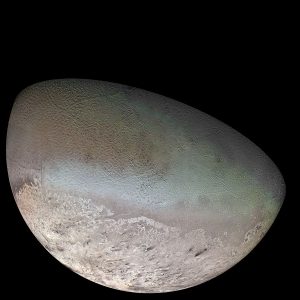Editor’s note: Astrobites is a graduate-student-run organization that digests astrophysical literature for undergraduate students. As part of the partnership between the AAS and astrobites, we occasionally repost astrobites content here at AAS Nova. We hope you enjoy this post from astrobites; the original can be viewed at astrobites.org.
Title: In situ formation of icy moons of Uranus and Neptune
Authors: Judit Szulágyi, Marco Cilibrasi and Lucio Mayer
First Author’s Institution: University of Zurich, Switzerland
Status: Accepted to ApJL
With over 100 moons between them, gas giants Saturn and Jupiter host most of our solar system’s satellites. Moons are thought to form in the gaseous circumplanetary disks (CPDs) that surround giant planets during their later stages of formation; the satellites develop from the disks in much the same way as planets themselves are formed.
But what about smaller planets like Neptune and Uranus? Today’s bite delves into the world of radiative hydrodynamical simulations to see whether CPDs — and thus moons — could also form around our ice giants.
The Real Moons
Given that Uranus hosts five major moons in similar, circular orbits, this ice giant’s satellites likely formed in a circumplanetary disk. A debris disk, like the one that may have formed our own Moon, is unlikely; debris-disk satellites would have very little water, which is not what we observe for Uranus’s moons.

Figure 1: Triton, as seen by the Voyager 2 spacecraft. [NASA/Jet Propulsion Lab/U.S. Geological Survey]
Let’s Form Some Disks
Forming a moon isn’t an easy job for a planet. Previous studies have revealed that there are two key planetary properties that determine how likely it is for a gaseous CPD to form around a planet — mass and temperature.
- Mass: Terrestrial planets like Venus are too small for CPDs to form; any satellites that exist around them are usually captured (as in the case of Mars) or the result of a planet–planet impact (as in the case of Earth).
- Temperature: CPDs are more likely to form if the planet is cooler, BUT a cooler planet radiates its formation heat faster and has less time to form a disk.
The authors deployed hydrodynamical simulations to recreate the later stages of planet formation for Uranus and Neptune. This involved setting the planets as point masses in the centre of the simulation surrounded by a gas disk, and then letting simulated nature (heat transfer, ideal gas laws, gravity) take over. For more details regarding hydrodynamical simulations, see this post on simulating the entire universe (!!) and this one on gas accretion.

Figure 2: Zooming in to the circumplanetary disk around Uranus (left column) and Neptune (right column). The different rows indicate the planetary surface temperatures: 100 K (top), 500 K (middle) and 1,000 K (bottom). [Szulágyi et al. 2018]
Simulated Moons vs. Reality

Figure 3: Formation timescale of moons around Uranus (left) with the distribution of their masses on the right. The red vertical lines represent Uranus’s 5 major moons. [Szulágyi et al. 2018]

Figure 4: Like Figure 3, above, the formation timescale of moons around Neptune (left) with the distribution of their masses on the right. The red vertical line represents the moon Triton. [Szulágyi et al. 2018]
So, overall, it is possible to form satellites around ice giants! This is an exciting result for exomoon lovers because Neptune-mass exoplanets are the most common mass category of exoplanet we’ve found so far. Furthermore, icy moons are the main targets for extraterrestrial life in our own solar system; ice-giant satellites elsewhere in the universe could be a similar source of potential in our search for habitable worlds.
About the author, Amber Hornsby:
Third-year postgraduate researcher based in the Astronomy Instrumentation Group at Cardiff University. Currently, I am working on detectors for future observations of the Cosmic Microwave Background. Other interests include coffee, Star Trek and pizza.

1 Comment
Pingback: AAS Nova – New